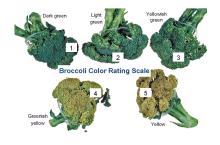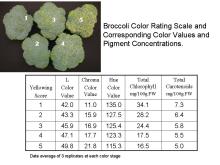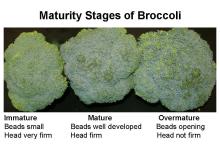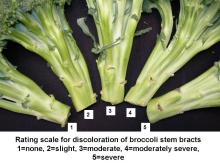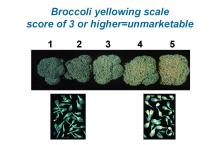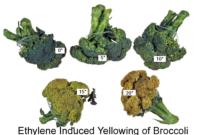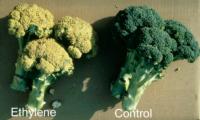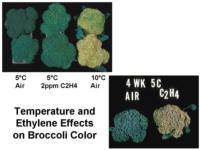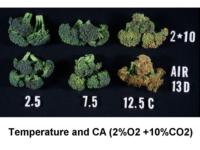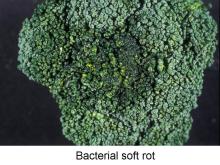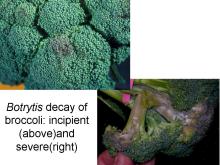Product Description
Índices de madurez
Head diameter and compactness; all florets (beads) should be closed.
Good quality broccoli should have dark or bright green closed florets. The head should be compact (firm to hand pressure), with a cleanly cut stalk of the required length. There should be no yellow florets and there should be no discoloration on the stem bracts.
Manejo y almacenamiento poscosecha
Low temperature is extremely important to achieve adequate shelf-life in broccoli. A temperature of 0°C (32°F) is required to optimize broccoli storage life (21-28 days). Heads stored at 5°C (41°F) can have a storage life of 14 days; storage life at 10°C (50°F) is about 5 days. Broccoli is usually rapidly cooled by liquid-icing the field-packed waxed cartons. Hydrocooling and forced-air cooling also can be used, but temperature management during distribution is more critical than with iced broccoli.
Freezing Injury. Broccoli will freeze if stored at -0.6°C (30.6°F) to -1.0°C (30°F). This may also occur if salt is used in the liquid-ice cooling slurry. Frozen and thawed areas on the florets appear very dark and translucent, may discolor after thawing and are very susceptible to bacterial decay.
Broccoli heads have relatively high respiration rates:
| Temperature | 0°C (32°F) | 5°C (41°F) | 10°C (50°F) | 15°C (59°F) | 20°C (68°F) |
| ml CO2/kg·hr | 10-11 | 16-18 | 38-43 | 80-90 | 140-160 |
The respiration rates of florets are slightly more than twice the rates of the intact heads.
To calculate heat of production multiply ml CO2/kg·hr by 440 to get Btu/ton-day or by 122 to get kcal/metric ton-day.
Broccoli is extremely sensitive to exposure to ethylene. Floret yellowing is the most common symptom. Exposure to 2 ppm ethylene at 10°C (50°F) reduces shelf-life by 50%.
>95%
Very low,
Broccoli can be benefitted by 1-2% O2 with 5-10% CO2 atmospheres at a temperature range of 0-5°C (32-41°F). Although under controlled conditions such low O2 levels extend shelf-life, temperature fluctuations during commercial handling make this risky as broccoli can easily produce offensive sulfur-containing volatiles. As a result, a high rate of air exchange is recommended in standard marine container shipments of broccoli. Most modified atmosphere packaging for broccoli is designed to maintain O2 at 3-10% and CO2 at about 7-10% to avoid the development of these undesirable off-odor volatiles.
Temperature & Controlled Atmosphere Photos
Title: Ethylene Induced Yellowing of Broccoli Photo Credit: Don Edwards, UC Davis | Title: Ethylene Yellowing Photo Credit: Michael Reid, UC Davis |
Title: Temperature and Ethylene Effects Photo Credit: Marita Cantwell, UC Davis | Title: Temperature and Modified Atmosphere Effects Photo Credit: Marita Cantwell, UC Davis |
Storage life varies considerably among broccoli cultivars. Shelf-life (appearance of any yellow beads = end of shelf-life) may vary from 12 to >25 days depending on cultivar: Shelf-life of different broccoli cultivars stored at 5°C (41°F), and 95% RH:
- Short (
- Moderate (20 to 25 days): Cascade, Embassy, Emperor, Esquire, Galaxy, Gem, Green Lady, Green Valiant, Hi Caliber, Midori #8, Pinnacle, Sakata #12, Schooner, Southern Comet, Vantage
- Long (>25 days): Citation, Galaxy, Glacier, Greenbelt, Legacy, Marathon, Mercedes, Packman, Pirate, Premium Crop, Shogun, Skiff
Desórdenes
Hollow Stem. An open area in the stem at the cut surface which may become discolored and decay; growing conditions and variety selection affect development of this disorder.
Floret (bead) Yellowing. The florets are the most perishable part of the broccoli head; yellowing may be due to overmaturity at harvest, high storage temperatures, and/or exposure to ethylene. Any development of yellow beads ends commercial marketability. Bead yellowing due to senescence should not be confused with the yellow-light green color of areas of florets not exposed to light during growth, sometimes called "marginal yellowing".
Brown Floret (bead). Is a disorder in which areas of florets do not develop correctly, die and lead to brown discolored areas. This is thought to be caused by plant nutritional imbalances.
Rough handling at harvest can damage the florets and increase decay. The force used to apply the water-ice slurry for cooling can also damage the florets on the heads and increase susceptibility to bacterial decay.
Bacterial decay. Various soft-rot causing organisms (Erwinia, Pseudomonas) may affect broccoli shelf-life. Rots due to these organisms are usually associated with physical injury.
Fungal pathogens. Although not as common as bacterial rots, gray mold rot (Botrytis cinerea) and black mold (Alternaria spp.) can infect broccoli heads; this may occur under rainy, very cool growing conditions.
References
References from scientifically validated sources will be added in the future.



